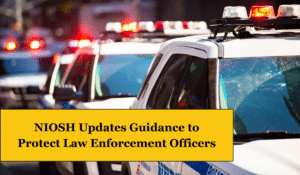Law enforcement officers face numerous dangers every single day. And yet, one in particular poses a hidden, yet pervasive occupational hazard: needlestick injuries.
These injuries occur when officers encounter hidden or improperly discarded needles or syringes during searches of individuals, vehicles, or properties.
The consequences can be severe, exposing officers to bloodborne pathogens like hepatitis B (HBV), hepatitis C (HCV), and even HIV.
While the perceived risk of contracting HIV from a needlestick is often overestimated (with studies showing a transmission rate as low as 0.3%), the threat of hepatitis remains significant, particularly for unvaccinated individuals.
NIOSH has released updated guidelines in its 2025 fact sheet, “Officers: Stay Safe from Needlesticks!”, to address these risks.
Here, we’ll break down the key recommendations and their implications for officer safety.
Related Article: Counterfeit PPE and the Illusion of Safety.
Related Article: The Benefits of Mobile Medical Testing.
Key Recommendations from NIOSH’s 2025 Fact Sheet
1. Preventive Training and Situational Awareness
NIOSH emphasizes training programs tailored to law enforcement scenarios. Officers must learn to identify high-risk situations (such as pat-downs or evidence collection) and adopt protocols like:
– Avoiding direct hand searches in areas where needles may be concealed.
– Using flashlights or tools to inspect bags or clothing.
Training should also cover post-exposure procedures, including immediate wound cleaning and reporting protocols.
2. Engineering Controls: Safer Tools and Equipment
Engineering controls are critical for minimizing exposure. NIOSH advocates for:
– Puncture-resistant gloves made from materials like Kevlar or nitrile.
– Sharps disposal containers in patrol vehicles or stations to safely store confiscated needles.
The guidelines also highlight innovations like retractable safety needles, though these are more common in healthcare settings.
3. Hepatitis B Vaccination: A Non-Negotiable Defense
HBV vaccination is a cornerstone of prevention. NIOSH stresses that employers must provide free HBV vaccines to all officers, as the vaccine is 95% effective at preventing infection.
Despite this, studies show gaps in vaccination rates, particularly among older officers or those in under-resourced departments.
4. Post-Exposure Protocols: Act Fast, Save Lives
If an injury occurs, immediate action is crucial:
– Clean the wound with soap and water or antiseptic.
– Seek medical evaluation within 2 hours to assess the need for post-exposure prophylaxis (PEP) for HIV or HBV immunoglobulin.
NIOSH also underscores the importance of documenting injuries to ensure access to workers’ compensation and track incident trends.
– Download the NIOSH 2025 Guidance on Needlestick Injuries.
Benefits for Law Enforcement Officers
1. Reduced Injury Rates and Long-Term Health Protection
Adopting NIOSH’s guidelines can slash needlestick injury rates to between 62 and 88%, according to CDC estimates. For officers, this translates to fewer missed workdays, lower healthcare costs, and peace of mind.
2. Compliance with OSHA Standards
Following NIOSH recommendations helps departments align with OSHA’s Bloodborne Pathogens Standard, which mandates safer devices, vaccination access, and exposure control plans.
Non-compliance not only risks fines but also endorses a culture of negligence.
– See OSHA’s Bloodborne Pathogens Standard (1910.1030).
3. Enhanced Trust and Morale
When agencies prioritize officer safety through training and equipment, it fosters trust between leadership and personnel.
For example, departments using puncture-resistant gloves report higher satisfaction rates, as officers feel better protected during high-stakes interactions.
The Role of Employers In Building a Culture of Safety
NIOSH calls on law enforcement agencies to implement comprehensive safety programs that include:
– Regular safety audits to identify gaps in equipment or protocols.
– Partnerships with occupational health providers for rapid post-exposure care.
– Transparent injury reporting systems to address underreporting, which remains a critical issue.
Bringing it Together
Needlestick injuries are preventable, but they require a proactive approach from both officers and employers.
By integrating NIOSH’s 2025 guidance into daily practices, law enforcement can mitigate risks and focus on their mission; protecting communities without compromising their own health.
As NIOSH notes, “Safety isn’t a one-time checklist; it’s a mindset.” Let’s make that mindset the standard.
Stay In Compliance With Worksite Medical
In most cases, OSHA requires medical surveillance testing, and at no cost to employees.
Worksite Medical makes that program easier with mobile medical testing.
We conduct drug and alcohol screenings, silica exam physicals, on-site respirator fit tests (including N95 masks), audiometric exams, as well as pulmonary function tests and heavy metal lab work, and much more, right on your job site. We also keep accurate, easy-to-access medical records for your convenience. You’ll keep your employees at work, and stay ahead of OSHA inspections.
With Worksite Medical, a mobile medical testing unit — we can bring all the resources of a lab to you. Our certified lab technicians can perform both qualitative and quantitative respirator tests to ensure a perfect fit.
Protect your team and your workplace now with Worksite Medical. Not sure what you need? Try our medical testing wizard here.
Give us a call at 1-844-622-8633, or complete the form below to schedule an on-site visit or to get your free quote.
Convenient, Compliant Occupational Medicine. Worksite Medical – Let Us Come to You!
"*" indicates required fields




